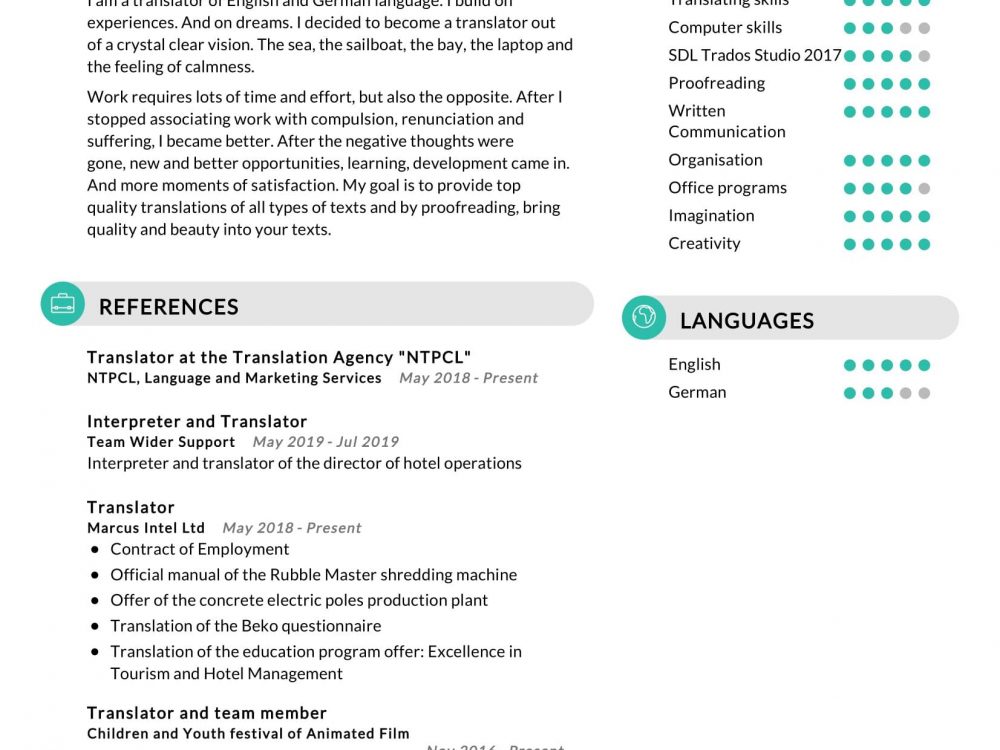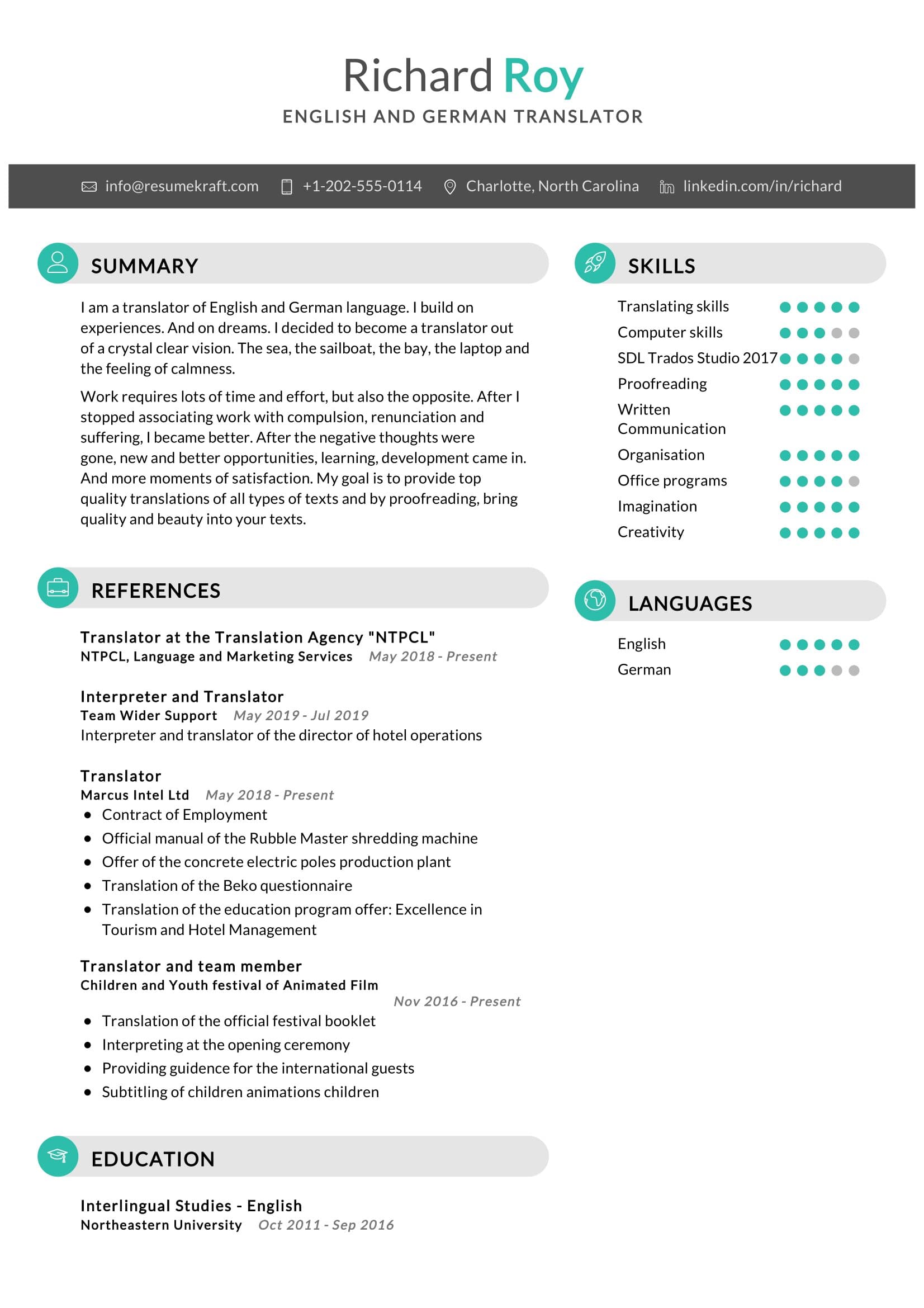Are you a Translator by profession and looking for an exciting career? We have good news for you! use our professional Translator Resume Sample. You don’t have to start writing from scratch. Just click “Edit Resume” and modify it with your details. Update the template fonts and colors have the best chance of landing your dream job. Find more resume samples.
Translator Resume Sample
Richard Roy
English and German Translator
Summary
I am a translator of English and German language. I build on experiences. And on dreams. I decided to become a translator out of a crystal clear vision. The sea, the sailboat, the bay, the laptop, and the feeling of calmness.
Work requires lots of time and effort, but also the opposite. After I stopped associating work with compulsion, renunciation, and suffering, I became better. After the negative thoughts were gone, new and better opportunities, learning, development came in. And more moments of satisfaction. My goal is to provide top-quality translations of all types of texts and by proofreading, bring quality and beauty into your texts.
Skills
Work Experience
Translator at the Translation Agency “NTPCL”
NTPCL, Language and Marketing Services
Interpreter and Translator
Team Wider Support
Translator
Marcus Intel Ltd
- Contract of Employment
- The official manual of the Rubble Master shredding machine
- The offer of the concrete electric poles production plant
- Translation of the Beko questionnaire
- Translation of the education program offer: Excellence in Tourism and Hotel Management
Translator and team member
Children and Youth Festival of Animated Film
- Translation of the official festival booklet
- Interpreting at the opening ceremony
- Providing guidance for international guests
- Subtitling of children animations children
Education
Interlingual Studies – English
Northeastern University
Interlingual Studies – German
German State University
Languages
- French
- English
- German
- Chines
Career Expert Tips:
- Always make sure you choose the perfect resume format to suit your professional experience.
- Ensure that you know how to write a resume in a way that highlights your competencies.
- Check the expert curated popular good CV and resume examples
Translator Resume with Writing Guide
The translator’s resume is one of those crucial documents that go along with being a translational professional. It’s not just your resume, but it also shows that you’re serious about your career as a translator. It’s for those who already have some translation experience under their belt and are looking to take the next step in their career.
In short, a translator resume is a tool you use to sell yourself as an expert in what you do and also help get you noticed by recruiters who are looking for translators and linguists. It’s definitely something that every translator should have in his or her arsenal, but does it have to be wordy, sort of boring, and pretty much hard to read?
Translator Resume Writing Guide:
Writing Your Resume: All About the Structure
The structure of a translator resume is similar to that of a normal resume (in other words, it’s pretty much the same with minor adjustments). It has your contact details (name, email address, and physical address), personal bio, and work experience in reverse-chronological order. There are also sections for languages you’re fluent in and specialties and tools you use as a translator.
If you don’t know where to start when creating your resume, this guide about some of the tricks and tips in getting your resume noticed by recruiters is all you need.
What’s Special About the Translation Resume?
One of the main things that makes a translation resume stand out from other resumes is that it’s designed specifically for translators and linguists. This is something that your potential employers can easily recognize and see that you’re a serious professional right from the start.
It has to be tailored just for you, with all the information that makes you really stand out for recruiters. And if it’s as easy to read as possible, then it will help you get more interview requests and ultimately improve your chances of getting a job offer.
Tips and Tricks for Writing the Perfect Resume
One of the best things about having a translator resume, like those we create here at Resume Mojo is that you get to choose how much information you want to put in the document. It’s not just your contact details and skills for languages, but also other information like awards, memberships, and even seminars you’ve attended that might be related to your field. It all depends on what you think will be most important when trying to attract recruiters or prospective employers.
Here are some tips for creating the perfect resume:
Personal Information: Personal information is still important in getting your resume noticed. Make sure you have your name, address (not just your city or state), email address, physical address, and even phone number. Make sure that they are clear and easy to read so it doesn’t confuse your potential employers or recruiters. If you’re applying for a job abroad, then put the country code in front of your number as well.
Translator Responsibilities:
- Work with a variety of subject matter and a wide range of documents, including correspondence, memorandums, reports, minutes of meetings, and other documents.
- Participate in group discussions with client personnel to establish objectives and comply with legal or technical requirements.
- Translate correspondence and document texts from one language to another according to style guides or company terminology manuals.
- Write letters, memos, resumes, reports, and other English language documents for non-English speakers.
- Read and assess a variety of materials, such as technical documents, journals, or economics texts.
- Communicate with non-English speaking clients to clarify details or resolve issues.
- Review translations for accuracy and effectiveness in style and substance.
- Listen to foreign language audio tapes and translate accordingly, using headsets or telephone equipment.
- Conduct research on unfamiliar terms by consulting reference books, periodicals or the Internet to ensure translation accuracy and proper style when translating text from one language into another for business purposes.
Top 10 Must-have Translator Skills:
- Reading, listening, and speaking multiple languages
- Address issues related to translation
- Work efficiently with documents and terminology
- Find and correct communication errors in documents
- Stay ahead of changes in the technical language of your field (including medical terminology)
- Create an effective bilingual working environment
- Understand your organization’s expectations in both languages you work with daily
- Report problems tactfully and clearly to clients and supervisors
- Be a patient listener who can deal with interruptions
- Stay in touch with resources available in your field. (includes websites and Internet tools)
Tips to write a Translator Resume Summary:
- While you can’t cover everything in a resume, you can still easily make the most of it in a resume summary. In this article, learn how to write a Translator Resume Summary that showcases the relevant skills, experience, and accomplishments that will get your foot in the door.
- The cover letter is one of the most important parts of your job hunt. In this article, learn how to write an effective cover letter tailored specifically for the position and give yourself the best chance at getting your dream job.
- The resume cover letter combo package helps you write a resume and cover letter that gets noticed and gets the job. A Translator Resume is a specific type of job seeker’s document that details an individual’s experience and qualifications to a potential employer who may or may not know anything about the person they are trying to recruit. Since resumes are typically designed to summarize the most relevant information about an applicant, they tend to be quite condensed. A translator will include in their resume information about their education, career history, certifications, and awards.
How to write a Translator Resume with No experience:
- First off, you need to have a good resume template and a Microsoft Word program. It is also very helpful to have ready two sample resumes: one for a freelance translator and one for a corporate one.
- After you have collected the necessary tools, the next step is to look up the job listings in your area or in your field of expertise, whichever you are applying for.
- Make an outline of the resume based on what companies are asking for in their job listings (i.e. the information that the hiring person is looking for )
- Also, do some keyword research to find out as much as possible about the job you are applying for. (i.e. how many translation projects were completed in a year, what are the most important keywords in your field of expertise)
- Write down all the relevant information you’ve found about this job at this point in time so you can use it as your “to-do” list on every new resume project when you encounter a translation job that interests you.
- Now that you have done the keyword research, put together your ideal target resume. From this point, you will need to start collecting and organizing some personal data about yourself. For this purpose, you can use an easy system called “ResumeKraft”. Learn how to customize and personalize your resume with Power Resume Builder!
- Once you have your information in place, start writing. Think about the skill set that best suits your job prospects. Which is the most important? For example, did they mention that they are looking for a translator with experience in X? Then put down X on the resume. Another thing to consider is if you have trouble translating certain words or phrases, try rewriting them into something easier to translate, then putting down this information too. Do not forget to add your own grammatical corrections!
How to write a Translator Cover Letter:
- Draft your letter in your own words, don’t copy anything from the internet.
- Review it and make sure it has the right structure and content; the layout is tricky!
- Send it to at least 2 of the places you’re applying to, preferably to 3-4. Add a personal touch by removing any information about yourself that won’t help you get hired through them.
- Edit it again, and repeat until you’re happy with the end result. If you send it to a company, ask for feedback – even if they don’t hire you, they should explain what needs improving.
- Keep your cover letter up to date when applying for new jobs.
Key Takeaways:
- A good resume is targeted, exciting, and reflects your personality and skills.
- Customize your resume with information that is relevant to each job you apply to.
- Make sure everything is correct and easy-to-read – spelling mistakes and hard-to-follow layout will get your resume thrown in the trash.
- Be enthusiastic and specific – avoid cliches or repetitive statements.
- Keep in mind that there is no formula for a perfect resume.


